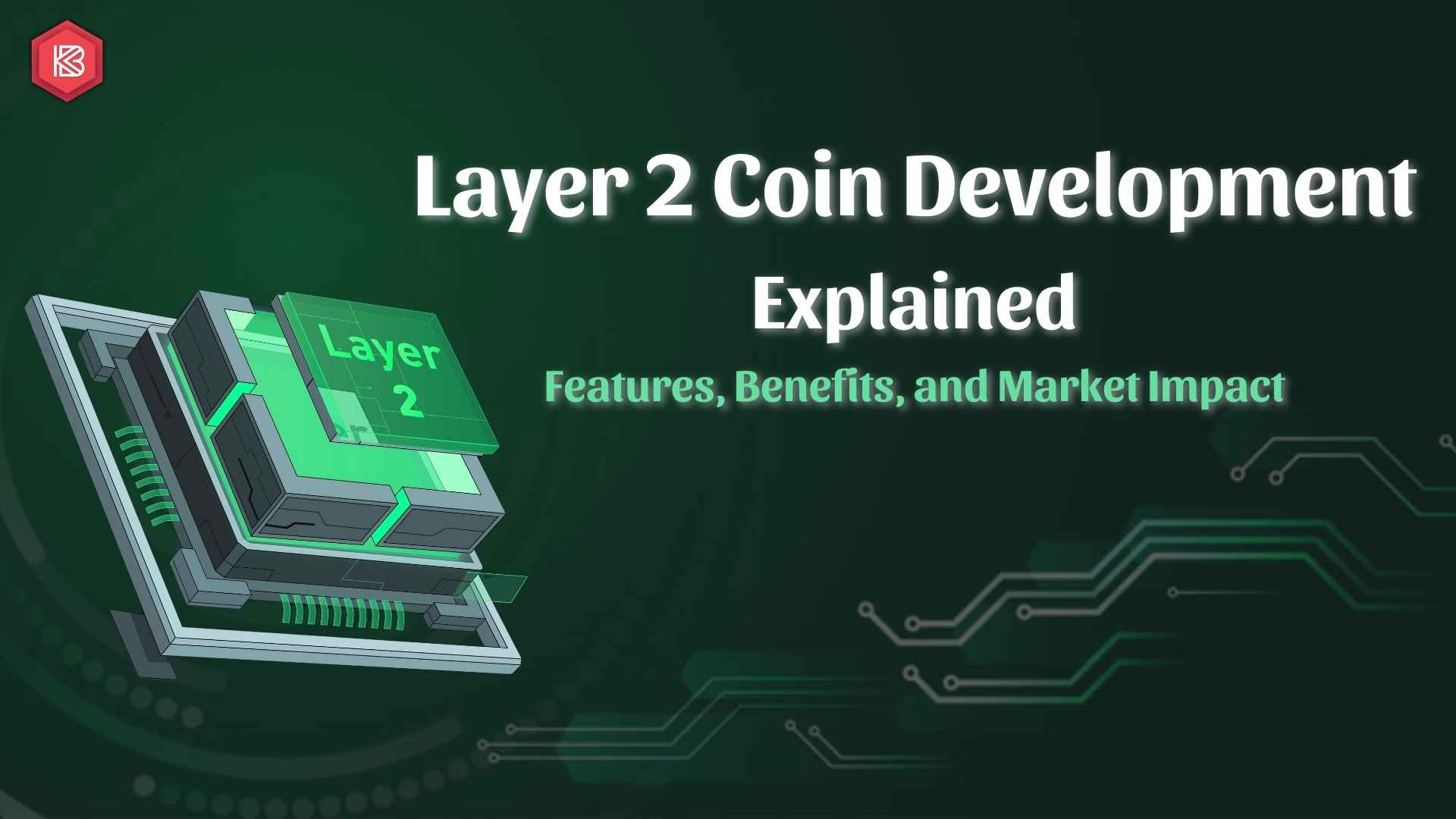Layer 2 Coin Development Explained

The purpose of Layer 2 coin development was to enhance the operational speed of blockchain networks. These coins entered the blockchain ecosystem to address scaling problems that affected Bitcoin, along with Ethereum. The concept became popular in the early years of the 2010s. The off-chain network infrastructure that operates above blockchain networks falls under the category of Layer 2. These protocols process transactions quickly. Among the widely recognized network layer solutions stands the Bitcoin Lightning Network, which advances payments while cutting expenses.
Layer 2 coins present multiple important advantages for the business sector. User experience, along with transaction speeds and fee prices, gets better through the use of these coins. The operational costs of businesses decrease, and the business operations result in increased profitability. The crypto market now depends extensively on Layer 2 coins because of expanding DeFi solution requirements. The parallel coins provide both improved financial gains and business revenue expansion.
Popular Layer 2 Coins In The Crypto Market
Polygon (MATIC)
Polygon is one of the popular layer 2 coins. It improves Ethereum. Transaction speed is increased, lowering costs. Its main goal is to provide a scalable and efficient network.
Optimism (OP)
Optimism focuses on scaling Ethereum and making it more efficient. It utilizes optimistic rollups. This helps reduce costs and increases overall network performance.
Arbitrum (ARB)
Arbitrum also works with Ethereum to speed up transaction processing. The platform uses rollups to handle many transactions at once. This helps the network operate faster and more effectively.
Loopring (LRC)
The decentralized Loopring exchange provides service through a layer 2 network architecture. Transacting at faster speeds, together with cost reduction, stands as its main objective. The cost-efficient and swift trading capabilities enable traders to have a better experience.
Immutable X (IMX)
The platform Immutable X exists to serve NFTs. The platform achieves its operations through a layer 2 network built for Ethereum. NFTs are processed at enhanced speed yet with reduced fees under the layer 2 network setup.
ZKSync (ZKS)
ZKSync operates through zero-knowledge rollup technology to enhance the functionality of Ethereum. As a layer 2 coin, this solution works to minimize payment charges while boosting operational velocity. The platform improves efficiency and scalability.
Core Benefits Of Layer 2 Coins
Scalability
Layer 2 coins significantly improve scalability. The second chain helps the main blockchain process increase transactions without becoming overwhelmed. Layer 2 implementation supports a more efficient network operation through reduced congestion along with lowered delay times.
Lower Fees
The cost of conducting transactions through Layer 2 networks proves lower than what users face when using the base Layer network. Users enjoy cost-effective services when they send coins and access decentralized applications through the platform.
Faster Transactions
The processing speed for transactions on Layer 2 is very fast. Faster transactions result from lowering the validation requirements on the main blockchain. Because of their speed and efficiency, Layer 2 coins excel at executing time-critical and small value-based transactions.
Improved Security
Layer 2 networks inherit the blockchain security. By using protocols like rollups or channels, Layer 2 coins maintain high security while offering more efficient transaction methods.
Enhanced User Experience
Users experience better interactions with systems because the transaction times and fees decrease. Users access dApps and finish transactions through blockchain networks while avoiding the time delays along expensive costs that exist in standard blockchain networks.
Interoperability
Different blockchains support the implementation of Layer 2 solutions at their upper levels. The cross-ecosystem integration enables them to operate between multiple blockchains while increasing the accessibility of Blockchain networks.
Top Real-Time Use Cases Of Layer 2 Coins You Should Know
Payment Systems
Fast and affordable transactions can be made through Layer 2 coins. The majority of blockchain payment systems utilize Layer 2 solutions to provide users with instant funds transfers, which remain inexpensive.
DeFi Platforms
In decentralized finance, Layer 2 coins enhance the speed of transactions. They also reduce cost,s making them suitable for lendin,g borrowing, and trading activities. DeFi platforms benefit greatly from these coins.
Gaming
Games based on blockchain gain speed in their in-game transactions through Layer 2 solutions. The trading process of digital game assets or currency between users becomes possible through the implementation of Layer 2 coins.
Micropayments
The payment functionality of Layer 2 coins makes them optimal for micropayments because they require minimal fees with swift transaction processing speed. The coins serve best for small monetary transactions, which include tipping creators and making purchases of little digital content.
Supply Chain Management
The tracking of goods and payments becomes more efficient by implementing Layer 2 coins in supply chain management activities. Bitcoin’s transparent nature supplements Layer 2 speed which generates instantaneous supply chain activity data updates.
NFT Marketplaces
Layer 2 coins enable NFT marketplaces to provide expedited transactions. These solutions support NFT market growth by reducing network congestion and transaction fees during the ongoing increase in NFT popularity.
Eminent Layer 2 Coin Development Process
Step 1: Requirement Gathering
The development begins by learning about all the objectives and targets intended for the Layer 2 coin. This includes studying the needs of the target users and deciding on the platform the coin will be based. Requirements must also be detailed for feature scalability and integration with existing networks.
Step 2: Design
Layer 2 coin begins with the architecture design. The architecture needs to support high throughput, low fees, and the desired security level. The design phase also covers selecting the consensus mechanism and protocols that will drive the network. UX and UI are essential to ensure the coin is easy to interact with.
Step 3: Development
During the development stage, the actual creation of the coin begins. The smart contracts are deployed. The main features of Layer 2 technology, including sidechains and state channels, and roll-ups help users perform fast transactions at lower costs. The network receives optimization efforts from developers who aim to boost its performance.
Step 4: Testing
After development, the platform must undergo rigorous testing. Testing ensures the Layer 2 coin operates smoothly under different conditions. Security testing is vital to avoid vulnerabilities. Stress tests help simulate network load while functionality tests ensure the coin’s features work as intended.
Step 5: Launch
Once the coin passes all tests, it’s time for launch. The launch involves deploying the coin on the blockchain. The coin distribution method often involves pre-sales together with airdrops. Organizations will conduct advertising drives to notify potential users, together with investors, about their products. Thorough coordination during launch time ensures network stability.
Step 6: Maintenance
The final step in the process is maintenance. Even after launch, the Layer 2 coin requires continuous monitoring. Regular updates provide performance and security. Feedback from users is analyzed, and new features are added to keep the network competitive and functional.
Conclusion
The future of business expansion through improved efficiency and enhanced scalability belongs to Layer 2 coin development. Users are increasing their adoption of blockchain technology, which makes Layer 2 solutions successively faster while decreasing transaction costs. The attractive nature of Layer 2 coin development appeals to business people, along with entrepreneurs and Web3 enthusiasts, during their efforts to widen their reach and improve customer service. The investment in Layer 2 development work creates automatic opportunities for substantial business growth, coupled with financial gains. A strategic approach enables businesses to discover profitable opportunities that lead to increased profitability. The technology shows strong growth potential alongside strong prospects of adoption, growth, and persistent development advancements.
As a leading Blockchain Development Company, Kryptobees ensures your Layer 2 coin development journey is expertly guided from start to finish. Our experience and commitment to innovation make us the ideal partner for this type of Web3 project. Contact Kryptobees now and take the first step towards transforming your blockchain business with Layer 2 solutions.
 Discuss Project!
Discuss Project!